Tobacco-Free Parks

Why are Tobacco-Free Parks Important?
Presenting
evidence to stakeholders and local government officials is critical
when establishing new public policy. Several areas of evidence related
to outdoor tobacco or smoke-free policies in municipal places are
generally presented. These “talking points” can be important when writing letters to elected officials and other decision makers. We offer you the following data.
1. Tobacco use is the single largest preventable cause of disease and premature death in the U.S.[4] Healthcare
costs in Connecticut directly caused by smoking amount to $1.63 billion
annually, not including costs associated with secondhand smoke,
smoking-caused by fires, spit tobacco use, or cigar and pipe-smoking.[5] This is a burden borne by all of us, whether taxpayers, employers, or consumers.
2. In 2010, the U.S. Surgeon General’s report concluded that there is no safe level of exposure to secondhand smoke;
breathing even a little indoor or outdoor secondhand smoke is not safe.
Secondhand smoke (also known as environmental tobacco smoke) is a
combination of the smoke from the end of the cigarette and the smoke
breathed out after each cigarette puff. When you are around people who
smoke, you inhale the same 4,000 dangerous chemicals in cigarette smoke,
including more than 70 chemicals that cause cancer. These include
benzene, toluene, lead and arsenic, just to name a few. Filtering air,
opening windows and separate “no smoking” sections do not provide
protection from secondhand smoke.
3. Health risks due to exposure to second hand smoke and tobacco smoke particulates include:
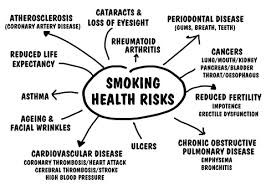
- Babies
are more likely to die of sudden infant death syndrome (SIDS), possibly
because, during pregnancy, many of the compounds in secondhand smoke
change the way a baby’s brain develops.[4]
- Children are also more likely to have lung problems, ear infections, and asthma from exposure to secondhand smoke [5]
- The
U.S. Environmental Protection Agency has classified secondhand smoke as
a Class A Carcinogen along with benzene, radon, and asbestos. Breathing
in secondhand smoke increases the chances of getting lung cancer by 20
to 30 percent.
- Adults
exposed to tobacco smoke are more susceptible to heart attacks and
stroke. This is because breathing secondhand smoke changes how the
heart, blood, and blood vessels function (blood platelets stick
together), the lining of the blood vessels becomes damaged, and adults
who are continuously exposed to secondhand smoke have higher “bad”
cholesterol making them more susceptible to heart attacks and strokes.
- Public
parks are designed to promote active living.Common sense tells us that
smoking has no place in an environment that offers playgrounds, ball
fields, and walking trails.We have leash laws and laws against drinking
in public, designed to promote a safe and healthy
environment.Tobacco-free ordinances are intended to do the same.
- Tobacco-free
parks model healthy behavior for our children.Research shows that
prohibiting smoking in public places decreases the chances that kids
will use tobacco products.[2]Such policies reinforce the fact that
smoking is not a healthy behavior.Every year more than 350,000 kids in
the U.S. start smoking, and roughly one third of them will die
prematurely from a disease caused by smoking. [3]
- Outdoors,
smoke can be smelled 23 feet away, and if someone can smell it, they
are inhaling cancer-causing and toxic chemicals.[6]The 2010 Surgeon
General’s report concluded there is no safe level of exposure to
secondhand smoke.The report also concluded that tobacco smoke contains a
mixture of more than 70 chemicals that cause cancer.[7]
- Cigarettes
are the most littered item in the United States and the world. A single
cigarette filter can take 5-10 years to decompose, and in the meantime
it is leaching toxins into the soil and water.Ingested cigarette butts
can be toxic to children and wildlife, and increase park maintenance
costs. [6]
- Discarded cigarettes are the third leading cause of preventable outdoor fires.[2]
What is the ENVIRONMENTAL IMPACT caused by tobacco?
- Cigarette butts are the most common form of litter. [8]
- At beach cleanups, cigarette butts are the most common form of trash found.[9]
- Within an hour of
contact with water, cigarette butts can begin leaching chemicals such as
cadmium, lead and arsenic into the marine environment. Cigarette butts
have been found in the stomachs of fish, whales, birds and other marine
animals, leading to ingestion of hazardous chemicals and digestive
blockages.[10]
- Cigarette butts not properly extinguished can cause fires.[8]
What is the HEALTH IMPACT caused by tobacco?
Some are listed below but there is a growing body of evidence that has been directly linked to tobacco use and exposure.
- The U.S.
Environmental Protection Agency has classified secondhand smoke as a
Class A Carcinogen, placing it in the same category as radon, benzene,
and asbestos.[11]
- Secondhand smoke
contains more than 4,000 substances, over 40 of which are known to cause
cancer in humans and many of which are strong irritants.[11]
- The Surgeon General has declared that there is no safe level of secondhand smoke.[12]
- Small amounts of secondhand smoke can trigger allergies, asthma attacks and other breathing problems. [11]
- Because their lungs
are smaller, children breathe in 50% more air pollution than an adult.
They are more susceptible to the dangers associated with tobacco smoke
even if outdoors.[11]
- A person sitting or
standing next to a smoker outdoors can breathe in wisps of smoke that
are many times more concentrated than normal background air pollution
levels.[13]
- Stepping on cigarette butts can result in burns.
- The vapor from e-cigarettes contains harmful chemicals. [14]
- "No matter how it's delivered nicotine is addictive and harmful for youth and young adults [15]
- Continine, an
alkaloid found in tobacco and used as a biomaker for tobacco exposure,
was higher in non-smokers exposed to e-cigarettes [21]
Background
CHART is a community coalition established through the Community Transformation Grant received by Eastern Highlands Health District (EHHD) in 2011 to promote active living, tobacco-free living, healthy eating, and clinical preventive services throughout Tolland County. Tolland County towns include Andover, Ashford, Bolton, Chaplin, Columbia, Coventry, Ellington, Hebron, Somers, Stafford, Tolland, Union, and Willington.
The CHART is made up of representatives from health care organizations, business, community organizations, education, early childhood education groups, family resource centers and representatives from different municipal programs and departments who are committed to the vision of a community where good health and wellbeing are possible for all residents.
Based on the Tolland County’s community health needs assessment some the towns show a higher prevalence from the state benchmark (45.5/100,000) for lung cancer and chronic lower respiratory disease and these figures impact figures for years of potential life loss. With these figures in mind, EHHD and CHART want to make every effort to provide health education outreach and support to all Tolland County municipalities that decide to go smoke –free in all public areas which are used by a large segment of the county’s residents.
You will find a list of all of the organizations that compose our CHART in this toolkit..
For more information or to learn about the Tolland County Community Transformation initiative, contact the Eastern Highlands Health District (860) 429-3325 or ehhd@ehhd.org
Purpose of the Toolkit
The purpose of this toolkit is to give communities strategies to develop tobacco-free polices in outdoor public spaces, methods to approach policy makers, examples of tobacco-free policies/ordinances that can be used as a guide for implementation, and examples of signage. A brief summary of research is presented, which supports why tobacco-free public places are important from a health, environmental, and economic perspective. The goal is that the reader will use this toolkit as a guide for developing policies/ordinances, and work with local elected officials who can adopt them.
Letter from the Directors of Health
Dear Park and Recreation Directors, Elected Officials, and Other Interested Parties:
Tolland County is noted throughout the state for its beautiful outdoor recreational opportunities. Our public parks are maintained for the use and enjoyment of our families and visitors. Making these parks tobacco-free makes sense. It protects users from the well-documented dangers of secondhand smoke, eliminates unsightly and unhealthy litter, and gives our residents the opportunity to model tobacco-free behavior – a powerful tool in teaching our children how to be healthy adults. What better place to model healthy behavior than the very places that provide opportunity for active living?
Tobacco-free public parks are becoming the norm in more and more places across the state and nation. Ellington, Colchester, East Lyme, Montville, Wallingford and Windham, as well as 839 other US cities and the entire state of Oklahoma have already adopted smoke- or tobacco-free park policies.[1] We hope that you will consider joining them. This toolkit provides information that will put you on the path to adopting your own tobacco-free ordinance or policy. For more information, contact us at the Eastern Highlands Health District or at the North Central District Department of Health.
Sincerely,
Robert Miller, MPH, RS
Director of Health, Eastern Highlands Health District
Fiduciary, Tolland County Community Transformation Initiative
Michael Pirro, MPH, MPA, RS
Director of Health
North Central District Department of Health
More information can be found at:
The Centers for Disease Control and Prevention
National Center for Chronic Disease Prevention and Health Promotion
Office on Smoking and Health
E-mail: tobaccoinfo@cdc.gov
Phone: 1-800-CDC-INFO
What is the IMPACT ON YOUTH caused by tobacco?
Discarded cigarette butts contain the tars absorbed by the filter and levels of bacteria from smoker’s mouths and lungs, thus posing a health hazard to small children who routinely tend to pick up items off the ground and place them in their mouths.
- American Poison Control Centers reported that over 5,162 children under the age of five were poisoned by the ingestion of cigarette butts in 2011.[8]
- According to the organization Tobacco-Free Kids, 3.5 % of high school kids in CT smoke and 14.7% use e-cigarettes.
- Tobacco use in family‐friendly places such as playgrounds, parks, and athletic events, models unhealthy behavior and normalizes the use of tobacco. When children see adults smoking, they see smoking as acceptable.
How to Get Started: Developing your Tobacco-Free Park Policy
"Greater community compliance will be achieved if the policy is easy to understand, the boundaries and areas covered under the policy are clearly identified, and active steps are taken to communicate its impact to all affected groups." -Tobacco Control Legal Consortium
Consider surveying park users to determine their thoughts.Besides providing insight on the level of support for tobacco-free parks in your community, it can also be helpful in identifying individuals interested in leading a campaign. Surveys can also be helpful later, in evaluating the success of your policy.
Steps to take:
- Develop your policy, using one of the sample policies included in this packet, or one of the many available online.
- Consider developing an enforcement policy.Many towns have determined that voluntary compliance is sufficient.
- Develop a plan to notify and educate the public.Publicize the new policy through the media. A sample press release is included in this packet.Post signs at all entrances and in strategic areas throughout the park.
What is the difference between a policy and an ordinance?
- Policy – a general term for a local government action that is legal, binding and enforceable.
- Ordinance– an act of local legislation that often includes a civil penalty or monetary fine up to a certain amount of money.
Other terms that may be helpful:
- Referendum – A direct vote where voters in a given jurisdiction either accept or reject a particular proposal (e.g., adoption of a smoke-free policy); proposals are referred to the ballot by the local governing body or by the state legislature or placed on the ballot through a citizen petition process.
- Binding – Permanent and able to regulate those who enter the outdoor area.
- Enforceable – Clear enforcement responsibility for controlling tobacco use in outdoor areas and clear ramifications such as monetary fines (civil penalties).
- Rules – Rules are NOT enforceable. They are meant as general guidelines for behavior and use of parks and beaches, etc. Those that fail to comply may end up violating another ordinance such as trespassing or failing to follow instructions of a peace officer.
- Legal – Originating from a local government body that has power over the outdoor area.
- Preemption – The existence of a state law that precludes stronger local laws; can prevent implementation of smoking bans or restrictions.
Tobacco Policy Survey Sample
(Adapted from City of Redding, California Smoking Policy Survey, September 2012 and Ringgold County, Iowa Public Health Parks Survey, 2010)
What is your gender? Male _____ Female _____ Other _____
What is your age? Under age 18 _____ Over 18 _____
Do you reside in (insert name of town)? Yes _____ No _____
How often do you visit a (insert name of town) park?
At least once a week  _____ At least once a month _____ At least once a year _____
_____ At least once a month _____ At least once a year _____
Does it bother you when people smoke in recreational areas? Yes _____ No _____
Does it bother you to see cigarette litter in recreational areas? Yes _____ No _____
Do you favor or oppose a tobacco-free policy at parks in (insert name of town)?
Strongly favor _____ Somewhat favor _____ Somewhat oppose _____
Strongly oppose _____ Don’t care _____ Don’t know_____
How strongly do you agree that kids act the way they see older teenagers and adults acting?
Strongly agree _____ Somewhat agree _____ Somewhat disagree _____
Strongly disagree _____ Don’t know _____
Do you think keeping youth from starting to use tobacco products is important?
Yes _____ No _____
Would you support a policy for parks in (insert name of town) to be tobacco free?
Yes _____ No _____
Do you think there would be a lot of opposition to a policy making all parks in (insert name of town) tobacco-free? Yes _____ No _____
When was the last time you used a tobacco product, including cigarettes, chew, snuff, cigars, vaping etc.?
Never _____ In the last week _____ In the last year _____
In the last five years _____ Longer than five years ago _____
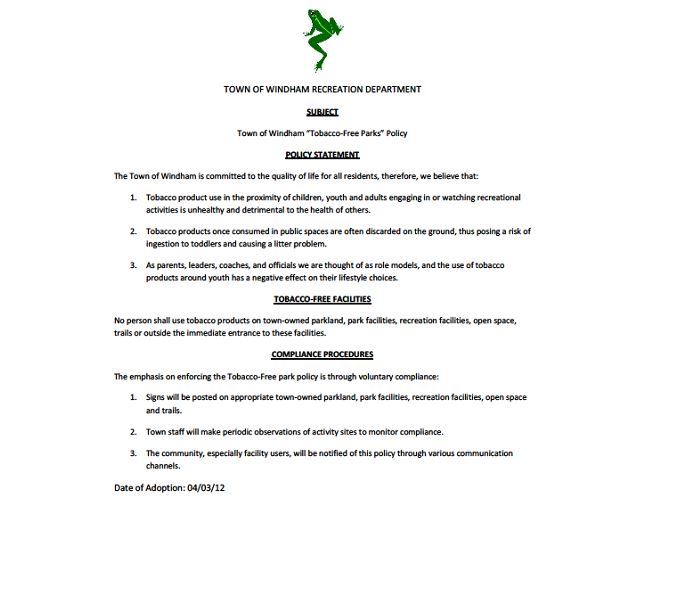
Sample Smoke Free Ordinance
On August 8, 2018 the City of Reno Nevada passed an ordinance prohibiting smoking of any kind including vaping. The ordinance is as follows:
Sec. 8.23.123 – Smoking Prohibited.
Smoking and tobacco use of any kind, including, but not limited to, the use of electronic or vaporized smoking devices, are prohibited in any park, trail or recreation facility or within 100 feet of sporting fields, spectator area, the entrances to all recreation facilities, and all sport and play areas unless within a designated smoking area.
Tobacco-Free Youth Recreation
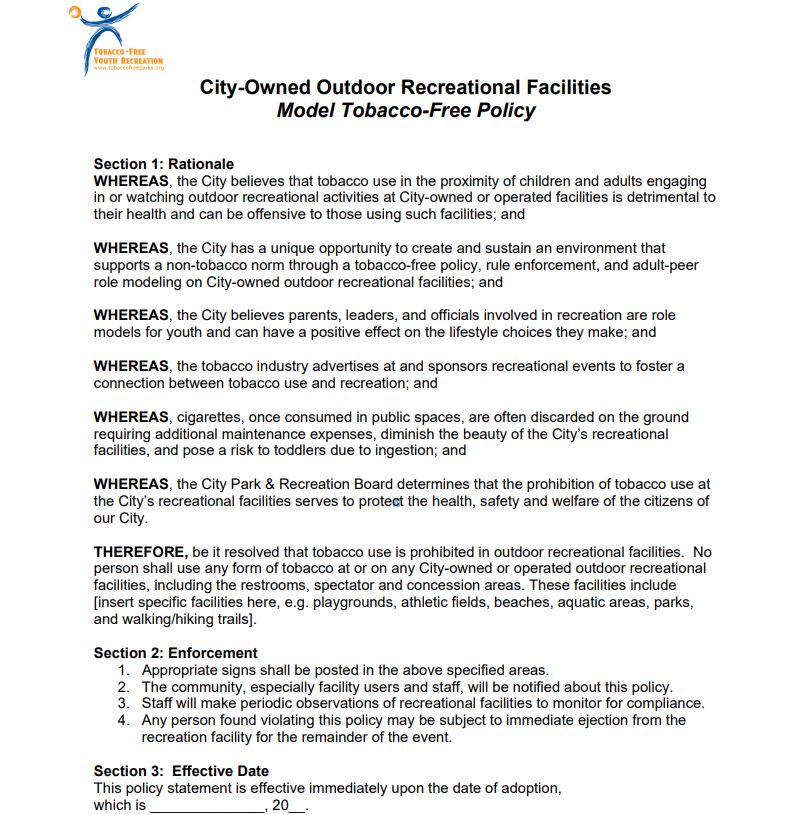
Ellington Town Ordinance, Adopted August 6, 2013
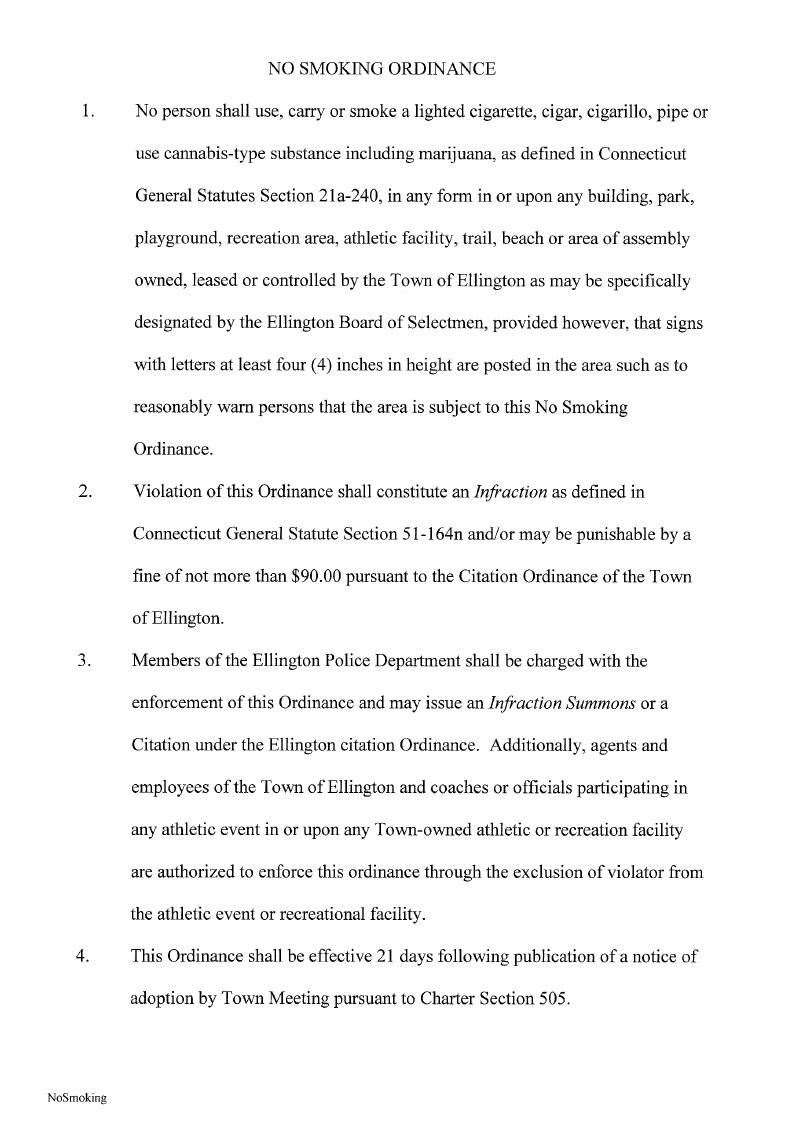
ALA Letter of Support for Local Ordinance
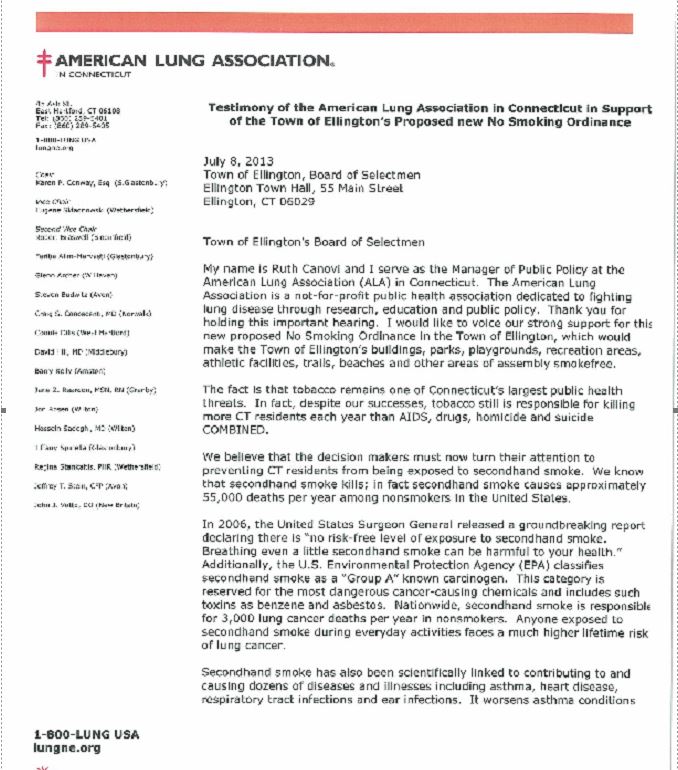
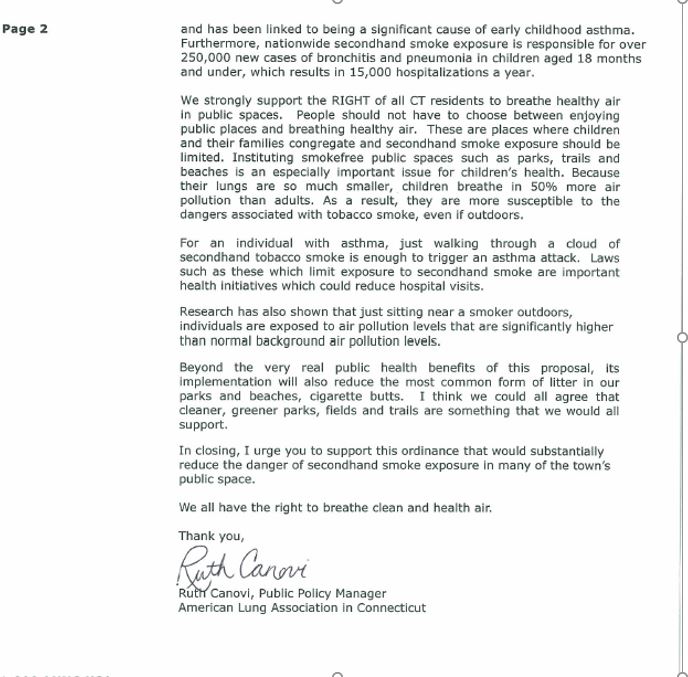
ALA Support Memorandum
Memorandum in Support
Smoke-Free Public Spaces Including Parks, Playgrounds and Beaches
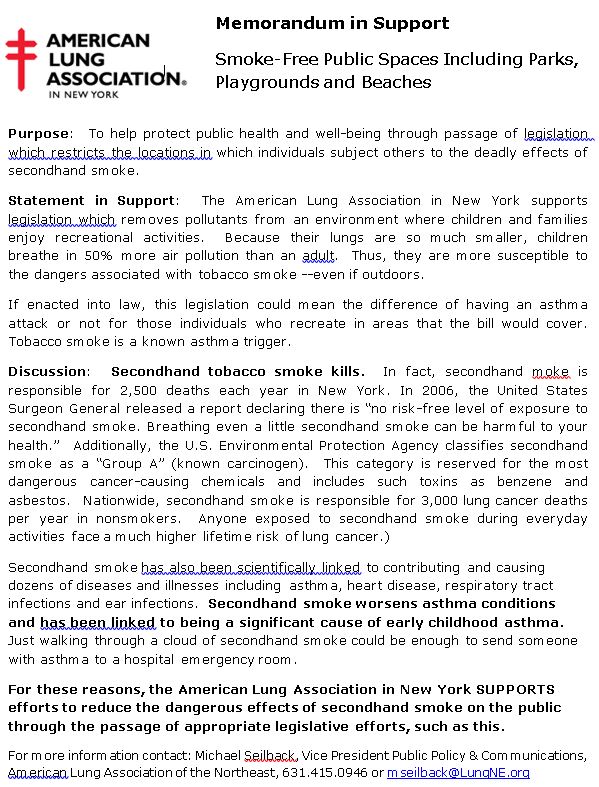
|
|
Sample Signage
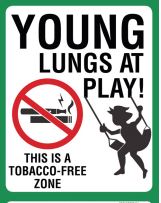
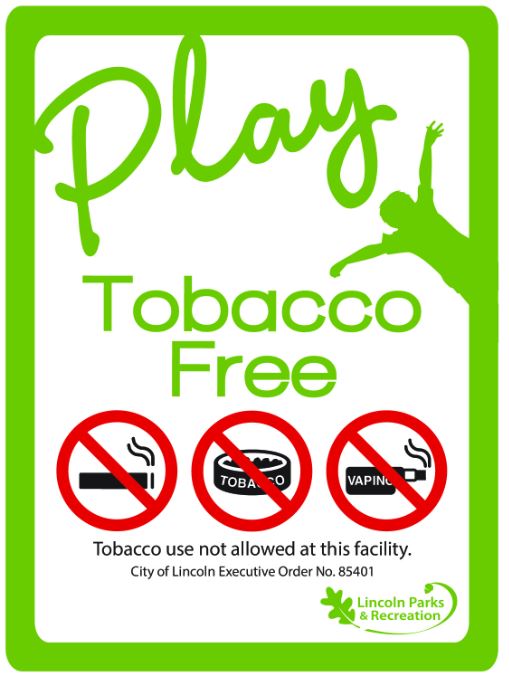
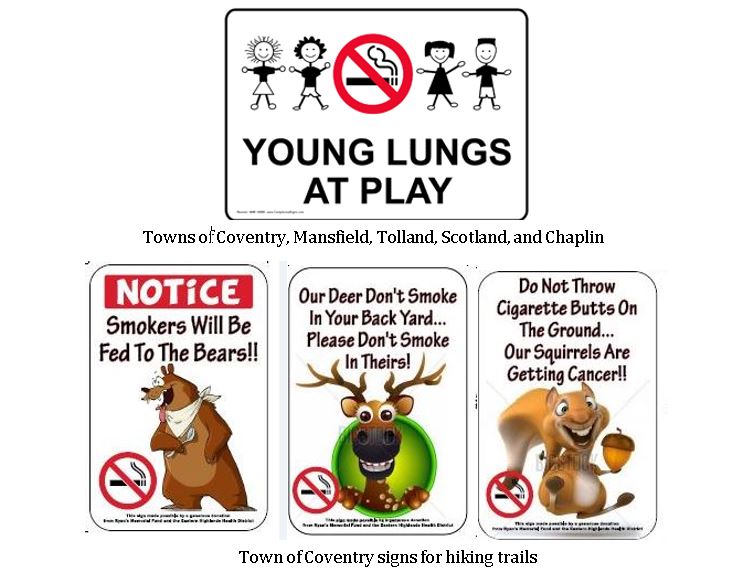
Enforcement
“But how can we enforce it?” is a question often asked by town officials when presented with a tobacco-free parks ordinance. The answer is “You don’t need to.”
"A key challenge with outdoor smoke-free policies is ensuring effective enforcement.
Most outdoor policies are self-enforced, which means they depend upon the cooperation
of the public – generally those who frequent the areas. Since most people will refrain
from smoking if they know a smoke-free policy is in place, the best way to enhance
enforcement is to educate the public and local businesses about the policy early and often
in the implementation process. Greater community compliance will be achieved if the
policy is easy to understand, the boundaries and areas covered under the policy are
clearly identified, and active steps are taken to communicate its impact to all affected
groups. " - Regulating Smoking Outdoors, The Tobacco Control Legal Consortium,
Community education, prominent and clear signage, and staff education are usually adequate for successful implementation of a tobacco-free policy/ordinance. According to the California Clean Air Project, “a critical component in addressing smoking in parks is to create an environment that makes the law known to park users. It is important to publicize the law in as many forms of media as possible –especially through City Parks and Recreation Departments.”
Ringgold County in Iowa reported that tobacco-free park policies are generally self-enforcing. “Many tobacco users look for ‘no tobacco’ or ‘no smoking’ signs. Those using the property also feel comfortable offering friendly reminders to others who may be unaware of park rules.” A local example is the Town of Windham which has a no smoking policy that is based on ‘voluntary compliance’.
Only 17% of adults in Connecticut use tobacco. Thus, the majority of people who use park facilities do not use tobacco and may not wish to be exposed to secondhand smoke. Since smoking is already banned in many public places such as restaurants, bars and state buildings, many people who use outdoor recreation facilities would prefer that they are smoke-free and may welcome a tobacco-free policy/ordinance.
Additional tips for communicating your policy and thanking people for not smoking in municipal parks include:
- Submit articles to local newspapers promoting your tobacco-free parks policy.
- Remind residents of your policy when speaking at events, concerts, or other community events.
- Print your policy on lease agreements, letters to residents, on utility bills, etc.
- Include a personal message to residents in recreation brochures, annual reports and catalogs.
- Include a written statement in rule books, coaching guides, and other materials distributed to athletic leagues.
- Use national campaigns such as Kick Butts Day or the Great American Smoke Out to distribute fact sheets on second hand smoke, promote cessation programs, and highlight tobacco-free parks policy.
- Post policies on municipal and school websites.
- Use public access channels, school television, or other media outlets.
- Remind staff by including a statement in personnel handbooks or other orientation materials.
Spreading the Word
Press Release Template
[city name] Celebrates Tobacco-Free Parks
[city name], CT— [city name] announced a new policy to promote the health of residents using city parks −a tobacco-free policy.
The occasion will be marked by a tree planting at [name] park. Representatives from _____ to prevent tobacco use, a local public health policy program will be planting a tree at the park on [date] at [time].
The policy affects all indoor and outdoor areas of the park, including parking lots. Tobacco users are welcome in the parks and can opt to either abstain, leave the grounds to smoke, or use nicotine lozenges while they’re at the park. Policies like this preserve the right to clean air. While there is no legal right to smoke, the public does have a legal right to clean air. Secondhand tobacco smoke is a serious health hazard, and research has found that it is dangerous in outdoor areas too. There is no safe level of exposure to secondhand tobacco smoke.
About 50,000 – 60,000 nonsmokers die every year in the US because of secondhand tobacco smoke.
Tobacco users who want to quit, can access many free services available through the
Connecticut QUIT Line 1-800-QUIT-NOW or CDC's How to Quit Smoking
Sample Public Address Announcement or Public Service Announcement
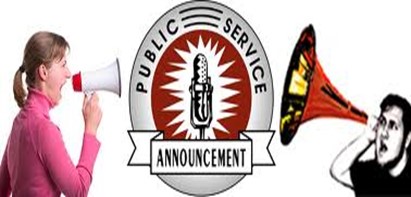
“As part of our effort to promote healthy lifestyles in our community, the [City name] Recreation Department would like to announce that all city parks and recreational facilities are now tobacco free! Chewing tobacco and smoking are not only deadly, but they also decrease lung power and weaken muscles, which leads to poor athletic performance. Exposure to tobacco smoke can cause immediate illness and long term health consequences. So stay in top physical condition by enjoying our tobacco-free parks, and make the choice to be tobacco free!” For more information or to learn how to quit contact your local health department or health care provider."
Using Social Media  Source:Google Images
Source:Google Images
- If your organization has a Facebook page, use it to promote messages that reinforce your decision to go tobacco free.
- Use Twitter and re-tweeting messages ( suggestions below)
Twitter is a social networking site (http://www.twitter.com). It offers a quick, inexpensive way to reach individuals and partners with timely health information and create a buzz (e.g., get people talking about a topic). Users send updates, or "tweets," that are 140 characters or less. Individuals can "follow" another user to see her/his updates.[15] To help your social media efforts, take time to browse Twitter content from the following three Twitter handles: @CDCTobaccoFree, @CDCObesity, and @MakingHealthEZ.
If you would like to use content from existing Twitter handles, it is recommended that you share as a “Re-Tweet” or “Modified Tweet”.
- A Re-Tweet (RT) is when a tweet is shared without any changes. Twitter’s Help Center has information on Re-Tweeting (https://support.twitter.com/articles/20169873-how-to-retweet-a-tweet#).
- A Modified Tweet (MT) is when a tweet is summarized or modified from someone else before sharing. If modifying a tweet, be sure not to change the tweet’s intended message. Another option is to create a new tweet and give credit to the originator. [16][17]
Additionally, you may want to consider using relevant hashtags. Hashtags are key words or topics in a tweet. To create a hashtag, use the # symbol in front of a word or phrase.[18] CDC has a few hashtags on community health topics such as #BloodPressure, #Diabetes, #Smoking. A complete hashtag list can be found at http://www.cdc.gov/socialmedia/Tools/Twitter-Hashtags.html.
Social media tools, guidelines, and best practices for Twitter can be found at http://www.cdc.gov/SocialMedia/Tools/guidelines. For more information about this, contact your DCH Communication Technical Assistance provider or send an email to dchcommunicationteam@cdc.gov.
CDC Best Practices for Preventing Tobacco Use
Across the nation, cities and towns are making incredible strides to prevent tobacco use. For years, the U.S. National Preventive Council and the Centers for Disease Control and Prevention (CDC) have been evaluating what works on a local level. In 2010, an important set of recommendations based on these “best-practice or evidence-based” interventions was issued as part of the National Prevention Strategy.[19] Best practices for municipalities include:
-
Encourage colleges and universities located in the community to adopt 100% smoke free policies.
-
Make all community events (fairs, parades, farmers’ markets, etc.) smoke-free.
-
Identify and monitor violation “hot spots”, where violators congregate.
-
Consistently apply penalties (such as fees and/or fines) for citizens who violate tobacco/smoke free policies.
-
Adopt a range of complementary anti-tobacco strategies, which includes aggressive media campaigns.
-
Regulate point-of-sale tobacco displays, e.g., require the posting of health messages.
-
Support a municipal ordinance to ban smoking in multi-unit housing.
-
Educate housing providers about the benefits of smoke-free housing.
-
Offer tax credits or other incentives for housing providers, to implement smoke/tobacco free police.
-
Regulate the sale of non-cigarette flavored tobacco products.
-
Regulate the sale of tobacco products based on pack size.
-
Regulate “roll your own” tobacco machines.
-
Broaden the smoke/tobacco free base of support by collaborating with other health and wellness efforts, such as asthma programs and active living initiatives.
-
Participate in state and local coalitions that promote anti-tobacco policies and smoking cessation programs.
-
Target anti-smoking, anti-tobacco efforts at populations who are disproportionately exposed: children, African Americans, low income individuals and blue collar workers.
-
Choose a variety of spokespersons to advocate for smoking policy reforms who are articulate, understand the issues and know what arguments the opposition will raise.
-
Provide up-to-date information on harmful effects of using tobacco, including vaping and e-cigarettes.
Local Resources and Cessation Services
Eastern Highlands Health District
4 South Eagleville Road
Mansfield, CT 06268
Contact Cecile Serazo at serazocc@ehhd.org
www.ehhd.org
American Lung Association of Connecticut
www.lung.org/stop-smoking
1-800-LUNGUSA or 1-800-586-4872
North Central District Department of Health
31 North Main Street
P.O. Box 1222
Enfield, CT 06083-1222
Phone: 860-745-0383
www.ncdhd.org
State of Connecticut Quit Line
1-800-QUIT-NOW
State and National Resources
- Connecticut Department of Public Health – Tobacco Use Prevention and Control Program. Phone: 860-509-8251, dphtobacco@ct.gov or go to: www.ct.gov/dph/tobacco
- Campaign for Tobacco-Free Kids: www.tobaccofreekids.org
- CDC Tobacco Free Sports Initiative: www.cdc.gov/tobacco/sports/index.htm
- Tobacco-Free Youth Recreation: http://www.tobaccofreeparks.org/materials.html
- Tobacco-Free Parks: For a Healthy Community – policy implementation resources from Minnesota such a model policies, fact sheets, policy guides and examples of signage. Available at: http://www.tobaccofreeparks.org/materials.html
- Model Ordinances: www.changelabsolutions.org/landing-page/secondhand-smoke
- Smoke Free Coalition one pager: www.nycsmokefree.org/sites/default/files/wysiwyg/docs/Citywide/vol_oa_factsheet_nyc_5.17.2013.pd
- Partnership for Prevention – Smoke-Free Policies: Establishing a Smoke-Free Ordinance to Reduce Exposure to Secondhand Smoke in Indoor Worksites and Public Places - An Action Guide. (October, 2007), Washington, DC: www.prevent.org
- U.S. Department of Health and Human Services, Centers for Disease Control and Prevention, Coordinating Center for Health Promotion, National Center for Chronic Disease Prevention and Health Promotion, Office on Smoking and Health [2006]. www.Surgeongeneral.gov/library/secondhandsmoke
- American Lung Association. Secondhand Smoke Fact Sheet: www.lungusa.org/site/pp.asp?c=dvLUK9O0E&b=35422
Community Health Action Response Team (CHART) Partner Organizations
- Eastern Highlands Health District
- North Central District Health Dept.
- American Lung Association, NE
- Central AHEC
- Visiting Nurse and Health Services of CT
- VNA East
- ECHN Women’s Services
- ERASE
- NECASA
- Mansfield Advocates for Children
- Coventry STEPS
- Chaplin CREW
- Scotland School Readiness
- Stafford Early Childhood Collaborative
- Vernon Youth Services
- Bolton Recreation
- Coventry Parks & Recreation
- Ashford Recreation
- Tolland Parks & Recreation
- UConn Club Sports Program
- Mansfield Parks & Recreation and Social Services
- Willington Recreation and Youth, Family & Social Services
References
[1] “Get the Facts - no-smoke.org.” [Online]. Available: http://www.no-smoke.org/getthefacts.php. [Accessed: 04-Apr-2014].
[1] “Tobacco Free Parks - Policy Implementation Guide.” [Online]. Available at: http://api.ning.com/files/rF76kE4CL0MAFpzNKJi8-0INPdnF1IOLxllVxMrL1o2qsFHJ7tps9jH3UbZO7zfJHwGOPu6GpLnJAHmjVGjVJv2SYAvtiAsf/TobaccoFreeParks_PolicyImplementationGuide_Final.pdf [Accessed: 04-apr-2014].
[3] Florida Department of Health, “Tobacco Affects us All,” Tobacco Affects us All, 2014. [Online]. Available: http://www.tobaccofreeflorida.com/Contents-13/Tobacco-Free-Beaches-and-Parks-/. [Accessed: 04-Apr-2014].
[4] Connecticut Department of Public Health, “DPH: Tobacco Use Prevention & Control Program,” 2014. [Online]. Available: http://www.ct.gov/dph/cwp/view.asp?a=3137&q=388060&dphNav_GID=1841. [Accessed: 04-Apr-2014].
[5] Connecticut Department of Public Health, “DPH: Adults and Tobacco,” 2013. [Online]. Available: http://www.ct.gov/DPH/cwp/view.asp?a=3137&q=388052&dphNav=%7C. [Accessed: 04-Apr-2014].
[6] Lake County Health Department and Community Health Center, “Tobacco Free Lake County Smoke Free Laws and Policies.” [Online]. Available: http://health.lakecountyil.gov/Population/Pages/Tobacco-Free-Lake-County-Smoke-Free-Laws-and-Policies.aspx. [Accessed: 04-Apr-2014].
[7] Centers for Disease Control and Prevention, “CDC - Fact Sheet - Health Effects of Secondhand Smoke - Smoking & Tobacco Use,” 2014. [Online]. Available: http://www.cdc.gov/tobacco/data_statistics/fact_sheets/secondhand_smoke/health_effects/. [Accessed: 04-Apr-2014].
[8] “CigaretteLitter.Org - The Facts About Cigarette Butts and Litter - Cigarette Litter.” [Online]. Available: http://www.cigarettelitter.org/index.asp?PageName=Home. [Accessed: 03-Apr-2014].
[9] “Ocean Conservancy: Homepage.” [Online]. Available: http://www.oceanconservancy.org/. [Accessed: 03-Apr-2014].
[10] “Keep Australia Beautiful Victoria - Sustainability Victoria.” [Online]. Available: http://www.sustainability.vic.gov.au/kabv. [Accessed: 03-Apr-2014].
[11] “US Environmental Protection Agency.” [Online]. Available: http://www.epa.gov/. [Accessed: 03-Apr-2014].
[12] Office on Smoking and Health (US), The Health Consequences of Involuntary Exposure to Tobacco Smoke: A Report of the Surgeon General. Atlanta (GA): Centers for Disease Control and Prevention (US), 2006.
[13] Stanford University, “Exposure to secondhand tobacco smoke in outdoor settings a risk, study shows,” 02-May-2007. [Online]. Available: http://news.stanford.edu/news/2007/may9/smoking-050907.html. [Accessed: 03-Apr-2014].
[14] A. Tan, S. Mello, A. Sanders-Jackson and C. Bigman, "Knowledge about chemicals in e-cigarette secondhand vapor and perceived harms of exposue among a national sample of U.S. adults," 5-Sep-2016. [Online]. Available: https://www.ncbi.nlm.nih.gov/pmc/articles/PMC5567734/http
[14] A. Bronstein, D. Spyker, L. Cantilena, B. Rumack, and R. Dart, “2011 Annual Report of the American Association of Poison Control Centers’ National Poison Data System (NPDS): 29th Annual Report,” 2012.
[15] U.S. Surgeon General, "Know the Risks, ecigarettes and Young People". [Online] Available: https://e-cigarettes.surgeongeneral.gov/ [Accessed: 12-Feb-2020]
[16] Centers for Disease Control and Prevention, “CDC - Social Media Tools for Consumers and Partners - Twitter,” 2014. [Online]. Available: http://www.cdc.gov/socialmedia/tools/twitter.html. [Accessed: 04-Apr-2014].
[17] Groves, J, “RT, MT, HT, via: The Importance of Giving Credit on Twitter,” 2011. [Online]. Available: http://socialmediacertificate.net/2011/02/rt-mt-ht-via-the-importance-of-giving-credit-on-twitter/. [Accessed: 04-Apr-2014].
[18] Groves, J, “MT on Twitter: The ever-evolving social medium,” 2011. [Online]. Available: http://socialmediacertificate.net/2011/08/mt-on-twitter-the-ever-evolving-social-medium/. [Accessed: 04-Apr-2014].
[19] Twitter Help Center, “Using hashtags on Twitter,” 2014. [Online]. Available: http://support.twitter.com/articles/49309-using-hashtags-on-twitter#. [Accessed: 04-Apr-2014].
[20] U.S. Department of Health and Human Services, “National Prevention Strategy,” 2011. [Online]. Available: http://www.surgeongeneral.gov/initiatives/prevention/strategy/. [Accessed: 04-Apr-2014].
[21] MontseBallbè,Jose M.Martínez-SánchezXiscaSureda,MarcelaFuace, RaúlPérez-Ortuñog, José A.Pascual, EsteveSaltó, EsteveFernández , "Cigarettes vs. e-cigarettes: Passive exposure at home measured by means of airborne marker and biomarkers", 2014, Available:https://www.sciencedirect.com/science/article/abs/pii/S0013935114003089
This toolkit was developed by Shayla Ranmal, North Central District Department of Health , Jordana Frost and Rita Kornblum from Eastern Highlands Health District with content substantially modeled after with permission from the ACHIEVE New London County Coalition. Updated 03/2020.